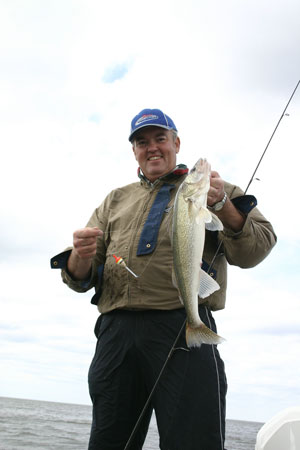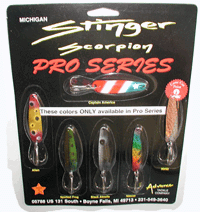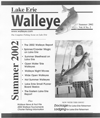|
Goin’
In for Late Summer Walleyes
by Ron Anlauf
Walleyes don’t always do what they’re
supposed to; It’s part of their challenging nature. If they did what they
should come late summer they’d all be found using deep offshore structure
and would stay put until after the fall turnover. It’s a classic pattern that happens on many of our
natural walleye lakes and is considered part of a “normal” progression.
However, this so-called normal progression doesn’t always happen, and when
it doesn’t anglers better take a look outside the box for answers to late
summer walleyes.
the fall turnover. It’s a classic pattern that happens on many of our
natural walleye lakes and is considered part of a “normal” progression.
However, this so-called normal progression doesn’t always happen, and when
it doesn’t anglers better take a look outside the box for answers to late
summer walleyes.
If you’ve been trying the deep stuff with
little or no success, you may have to step back and take a new look at what,
when, and especially where, you’re doing what you do. While the “what and
when” are important considerations, the “where” is always the most critical
piece to the walleye puzzle. Occasionally, the “where” is so far outside the
norm that it doesn’t make much sense, unless you dig a little deeper, or
shallower, as the case may be.
One of those unusual scenarios occurs
during the mid to late summer period, and revolves around weed growth not
normally associated with good walleye fishing. The weed growth in question
involves the shallowest growing varieties, like reeds and even lily pads,
heavy on the reeds. The key to making it all happen is dark or stained
water, and is a pre-exquisite to sustaining a good daytime bite.
Walleyes will make use of whatever food
sources are available, no matter where it happens to be hiding. Reed banks
can hold all kinds of bait, including schools of minnows, perch, as well as
immature sunfish and crappies, and is a fact that walleyes are well aware
of. The key to a walleye’s heart is through his stomach, and he will never
be far from his next meal.
Yanking ol’ marble eyes from heavy
vegetation, like reeds, requires some unconventional thinking. For example,
the ultra light finesse techniques that are normally associated with a light
biting fish, will get you nowhere in a heavy jungle, especially if you have
to go in after them. Instead, you’ll have to sacrifice finesse for something
that can get the job done, like heavier line in at least the ten pound test
range. The heavier line will have a negligible effect on your ability to get
a walleye to take the bait, and give you a much better chance of putting the
fish in the boat.
Another variance would include using
longer stouter rods, which can give you more power to get a a crazed fish
out of the really thick stuff. They can also give you more range, which
comes in handy if you happen to be dropping the bait into the pockets.
When walleyes head this shallow they seem
to take on a whole new more aggressive attitude. In fact the fight and
thrashing that your first thin water walleye exhibits might have you
believing that you’ve tied into something else like a northern pike, or a
largemouth bass. You won’t know for sure, that is until you get a good look
at the glaze in those spooky looking eyeballs.
While the gear for boating walleyes in
heavy cover requires a few changes, some of the basic presentations remain
the same, like jigging, and using slip bobbers. A jig and live bait
combination can be one of your top choices, depending on the conditions. The
jig can be worked from the outside of the reed bank, to right smack in the
middle of it. Weedless jigs like the Northland Tackle Weed-Weasel allow you
to get a bait into some of the thickest cover without constantly hanging up.
The Weed-Weasel has a plastic “Y” weed guard that protects the hook but
collapses under the pressure of a biting fish.
Jigs in the 1/8 to 1/4 ounce range should
be all you need. The idea is to use as light a jig as possible, and still be
able to get the bait to the bottom. Good tipping baits include medium to
large sized leeches and crawlers. Jumbo leeches will still get you plenty of
bites but the bigger bait will result in more missed fish. Crawlers can be
hooked once through the middle, or try simply using half of it, and then
thread it on the jig. Many times less can definitely mean more in numbers of
fish boated.
A jig and live combination suspended
beneath a slip float is another good option and can be a big advantage if
the bottom happens to be covered with slime. The float will keep the bait
out of the goop and hold it up where it can be found by roving ‘eyes.
The key to working a reed bank is to start with the outside edge and pick
off what you can, before you decide to move right in. By doing so you’ll
reduce the risk of spooking fish that could have otherwise been caught.
Another key is to keep moving and working and not give up, even if the first
reed bank or two comes up empty. So many times there will be a small area,
in a certain patch, that gives up most of the fish. Your job is to find it,
and there is no easy way to get it done. See you on the water.
|





